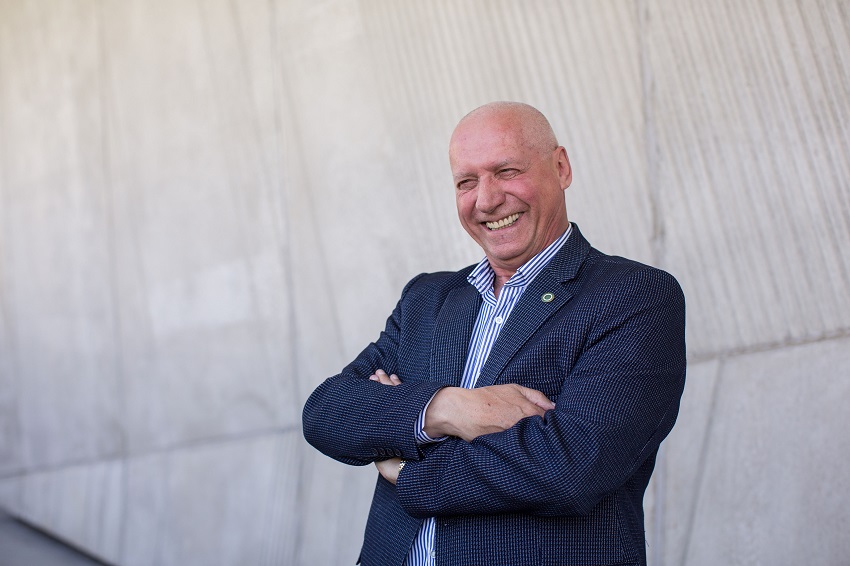Leading the world in stroke prevention

This year’s World Stroke Day campaign encourages everyone to use the free Stroke Riskometer mobile app developed at AUT by Professor Valery Feigin.
AUT and Stroke Central Region will co-host the official launch of the world stroke campaign in New Zealand, livestreaming from the university’s city campus today at 9.30am.
#DontBeTheOne is a key initiative of the World Stroke Organization (WSO) in its commitment to Cut Stroke in Half. It is the first world stroke campaign to focus on population-wide prevention and aligns with the United Nations’ Sustainable Development Goal #3 – ‘To ensure healthy lives and promote wellbeing for all at all ages’. One of the specific health targets is to reduce premature mortality from Noncommunicable Diseases (NCDs) by a third by 2030. However, a UN report showed that 138 governments had demonstrated very poor or no progress towards their time bound commitments.
The latest analysis from the Global Burden of Disease shows that that the lifetime risk of stroke, for those aged over-25, now stands at one-in-four. Stroke is a leading cause of disability and death worldwide, yet it is largely preventable. Almost 90 percent of strokes can be attributed to a few behavioural and lifestyle risk factors that can be easily modified, such as high blood pressure, physical inactivity and smoking.
The WSO believes that accessible smartphone technology can help tackle widespread stroke prevention, even in low-income settings. Validated technologies like the Stroke Riskometer (available for free in 14 languages on the AppStore and GooglePlay) are moving fast and show unprecedented uptake among the public and health professionals alike, with almost 200,000 downloads across 78 countries prior to the world stroke campaign.
The Stroke Riskometer is an easy-to-use tool for assessing your risk of stroke and what you can do to reduce that risk. It boasts a unique algorithm that combines age, gender, ethnicity, lifestyle and other health factors to calculate personal stroke risk. The mobile app successfully addresses a major barrier to stroke prevention – how to make medically accurate and reliable information on personal stroke risk accessible to populations worldwide.
Professor Feigin, Director of the National Institute for Stroke and Applied Neurosciences at AUT, is considered one of the world’s most influential scientific minds – ranking among the top one percent by citations for his global research on the epidemiology, management and prevention of stroke and traumatic brain injury. He says primary stroke prevention needs an overhaul.
New Zealand employs a ‘high-risk strategy’ in stroke prevention, using a Cardiovascular Disease (CVD) risk screening system. However, current CVD risk assessments do not include most of the behavioural and lifestyle risk factors that contribute to the vast majority of strokes. By definition, high-risk strategies exclude people at low to moderate CVD risk, who ultimately make up 80 percent of all strokes and heart attacks. This group receives no recognition, education or other preventative initiatives.
“Stroke prevention should be population-wide, rather than only targeting those at high risk. This would not only have an impact on stroke, but cardiovascular disease and the whole range of noncommunicable diseases. The results would be clearly evident within the first year or two,” says Professor Feigin.
“The greatest harm of high-risk strategies is that they mislead policymakers and health professionals into thinking they can tick the box and the problem of prevention is sorted.”
There is a growing body of evidence to support both the medical and cost effectiveness of population-wide strategies. However, there is still no country in the world where they have been implemented in full. OECD countries allocate less than three percent of health spending on average to public health and prevention initiatives. Almost half of this is spent on less cost-effective measures, such as high-risk screening.
“Let’s make New Zealand the first country in the world to implement a full stroke prevention strategy. A sector-wide district health board deficit of more than NZ$1billion highlights the unsustainable cost of inaction,” says Professor Feigin.
The urgent need for action at an individual and population-wide level is only matched by the potential for a huge reduction in stroke.
JOIN #DontBeTheOneNZ
Download the free Stroke Riskometer mobile app. Calculate your stroke risk percentage. Make small lifestyle changes to reduce that risk. And, share your progress on social media using #DontBeTheOneNZ.
Stroke Central Region is the official partner of the world stroke campaign in New Zealand. The Wellington-based non-profit organisation for stroke survivors and their whānau will host a series of events throughout the year, inspiring people to be active and improve their lifestyle.
You can contribute to population-wide change with a click.
Every Stroke Riskometer download is a vote of support for stroke prevention.
Useful links:
- Download the Stroke Riskometer mobile app
- Livestream: official launch of the world stroke campaign in New Zealand
- Stroke Central Region
- World Stroke Organization
- #DontBeTheOneNZ
- World Health Organization - Noncommunicable Diseases
- Progress on the prevention and control of non-communicable diseases : report of the Secretary-General
- Global Burden of Disease
- National Institute for Stroke and Applied Neurosciences
- Primary stroke prevention needs overhaul
- DHB Sector Financial Reports 2018–19